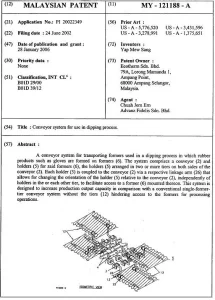In a recent case at the IP Court in Kuala Lumpur, the Court held that Ecotherm (TFT) Sdn Bhd’s Malaysian Patent No. MY-121188-A was valid but at the same time held that the parties sued by Ecotherm in this case were not infringing the said patent.
The patent infringement action in question relates to the conveyor system for transporting formers used in a dipping process in which rubber products such as gloves are formed on the formers. The suit was brought by Ecotherm (the plaintiff) against Kendek Industry Sdn Bhd (the 1st defendant) and other defendants – Tuck Hua Engineering Sdn Bhd (the 2nd defendant) and Top Glove Sdn Bhd (the 3rd defendant).

The plaintiff claimed that the defendants had infringed the patent by having jointly or severally made, offered for sales and sold, stocked for purposes of offering for sales, sold or used conveyor systems and holder assembly which consist of features identical with and having similar functions to or equivalent to the claimed elements and functionalities of the said patent prior to as well as post-grant of the patent.
The defendants had rigorously defended themselves in this case and raised a lot of issues against the patent in order to safeguard their interests. They argued that the invention as claimed in the patent is not new and did not involve an inventive step, and was therefore unenforceable and should be invalidated. The defendants submitted four prior art, namely GB Patent No. 911654, US Patent No. 5,909,800, GB Patent No. 2213760 and a prior publication and sale of a conveyor system in Taiwan as early as November 1996 to support their case.
They also argued that some of the terms in the patent specification were ambiguous, that the patent specification did not have an enabling disclosure and that some of the amendments made during the prosecution of the patent were beyond what was originally disclosed in the patent specification as filed.
According to the defendants, the plaintiff did not have a right to bring an action against them because the patent is owned by Ecotherm Sdn Bhd and not by the plaintiff, Ecotherm (TFT). The plaintiff argued that Ecotherm Sdn Bhd had assigned the rights to the patent to it by way of an “assignment” on 3 November 2006. However, according to records made available to the Court, the “assignment” signed by Ecotherm Sdn. Bhd. and the plaintiff was merely a license agreement to allow the plaintiff to sell the product in question in Malaysia and not an assignment of rights and therefore Ecotherm Sdn Bhd was the actual owner of the patent.
Novelty
The Court held that the patent was novel as none of the prior art documents relied on by the 1st defendant was anticipated by the claims. It held that the major difference between the patent and the prior art was in the way the two-tier system as claimed in the patent operates. The Court noted that the patent overcame the mechanical limitations and inefficiencies posed by the prior existing two-tier systems. These differences enabled Ecotherm’s patent to achieve technical advantages as well as the superior technical effects which were previously lacking in the prior art machines.
Inventive Step
The Court held that the modifications and inventive ideas disclosed in the patent were not simply obvious or plain workshop improvements that a person skilled in the art would have been able to come up with without reading the patent. Accordingly, the invention as embodied in the claims of the patent has significantly improved on what existed before and solved many of the technical longstanding problems in the industry.
Ambiguity and Insufficiency
Having considered all the evidence tendered in Court in its entirely, the Court held that the specification, which includes description, claims and drawings of the patent, is sufficiently clear, precise and complete to enable a person who has ordinary and reasonable skills and knowledge in the relevant industry to evaluate and carry out the invention as disclosed and claimed. This is because the defendants have failed to establish that the description or any of the claims of the patent was ambiguous, insufficient or not fully supported.
Unlawful Amendments
The Court held that the amendments cannot be regarded as amendments that have gone beyond the disclosure of its initial application.
Infringement
The Court held that none of the evidence adduced by the plaintiff had sufficiently proven that the products being manufactured and sold by the defendants had infringed the patent.
Conclusion
The case highlights three important factors in patent matters. One, for a patent to be valid and enforceable, it must be drafted very diligently. Use of professional patent drafters is crucial in this context. Second, this case also proves that it is possible and legal for other parties to work around claims of a patent and avoiding infringement by doing so. Again, professional advice is necessary here to ensure that the product that has been developed does not infringe any patent. This can be achieved by engaging an IP practitioner to issue a freedom to operate (FTO) opinion.
Last but not least, if you are a patent owner and are thinking of assigning your rights to a third party, please ensure that the agreement to transfer your rights is properly worded, to avoid circumstances such as in this case, where what the plaintiff, Ecotherm TFT, thought was an assignment of rights was merely a license agreement.







